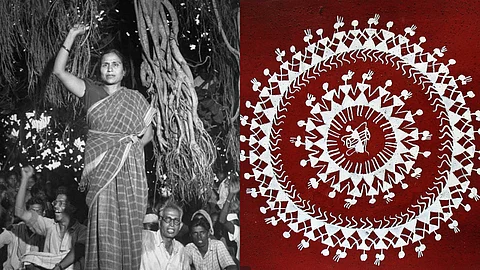
- HOMEGROWN WORLD
- #HGCREATORS
- #HGEXPLORE
- #HGVOICES
- #HGSHOP
- CAREERS
- ABOUT US
- CONTACT US

Nestled in the Western Ghats of Maharashtra, India, resides the Warli tribe, a community with a rich cultural heritage and a profound connection to nature. However, for over a century, their lives were marred by a harsh reality — a feudal system that exploited their labour and denied them basic rights. In 1945, a simmering discontent erupted into the Warli Adivasi Revolt, a pivotal moment that challenged the status quo and sowed the seeds of future struggles for indigenous rights.
The roots of the revolt lay in the oppressive practices of landlords and moneylenders. The Warli people, primarily small-scale cultivators, were subjected to bonded labor, a system that trapped them in a cycle of debt. This exploitation extended beyond the fields, with a form of marriage slavery known as lagnagadi further tightening the landlords' grip. The meager wages they received were insufficient to meet their basic needs, leaving them perpetually vulnerable.
The turning point came in May 1945, when nearly 5,000 Adivasis, primarily from Dahanu and Talasari talukas, converged on Zari village in the then Umbargaon (now Talasari) tehsil (area) of Thane district in Maharashtra. This gathering was a collective declaration of defiance. Under the leadership of the Communist Party of India (Marxist), particularly Shamrao Parulekar and Godavari Parulekar (affectionately known as ‘Godutai’, which translates to ‘elder sister’), the Warli people raised a powerful demand — fair wages of 12 annas a day for their labor.
Godutai, a crucial figure in the movement, played a vital role in mobilizing women. Traditionally marginalized, Warli women stepped out of their shadows, attending meetings, sharing their experiences of oppression, and encouraging others to join the fight. This collective action sent a strong message — the Warli people, united under the red flag of the Kisan Sabha (All India Peasants and Workers Party), would no longer be silent.
The revolt wasn't confined to speeches and demonstrations. The Warli people refused to work in the landlords' fields until their demands were met. This act of protest disrupted the exploitative system and forced the landlords to acknowledge the growing discontent. The revolt's impact transcended the immediate context. It served as a spark, igniting a series of later struggles against specific aspects of the feudal system, such as vethbigar (forced labor) and lagnagadi.
The long-term consequences of the Warli Adivasi Revolt are still felt today. The movement instilled a sense of unity and empowerment within the Warli community. It also laid the groundwork for the enduring influence of the Communist Party in the region, evident in their continued electoral success. However, the fight for complete liberation continues. The Warli people still face challenges related to land rights, resource access, and deforestation.
The story of the Warli Adivasi Revolt has been strategically obscured from the pages of mainstream history by the those in power but it is beyond a shadow of a doubt that this movement is a potent example of the power of collective resistance. It serves as a reminder that even the most marginalized communities can challenge the status quo and demand justice. As we move forward, understanding this episode becomes crucial in addressing the ongoing issues faced by indigenous communities in India and around the world. The resilience and courage of the Warli people stand as a beacon of hope in the ongoing struggle for a more just and equitable society.
